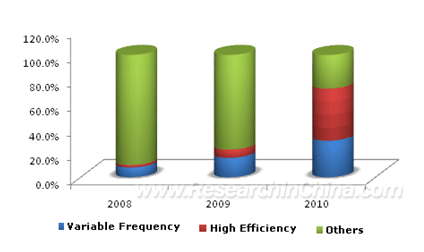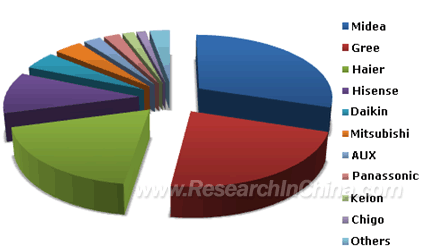In the second half of 2010, China adjusted the fiscal subsidy policy for high-efficiency air conditioner, which was a turning point for China’s inverter air conditioner market to usher in a full-blown development stage. The slash of fiscal subsidy for high-efficiency fixed-frequency air conditioner shortened the price gap between high-efficiency fixed-frequency air conditioner and high-efficiency inverter air conditioner; as a result, inverter air conditioner products with better performance have seen a remarkable growth in the sales volume. In 2010, the domestic market occupancy of inverter air conditioner surged to 29.8% from 15.8% in 2009.
Retail Volume Structure of China’s Air Conditioner Market, 2008-2010  Source: ResearchInChina
In terms of competition pattern in the inverter air conditioner market, Midea takes the leading position.
In 2010, China’s major air conditioner brands including Midea, Gree, Haier, Hisense, AUX, Kelon and Chigo took up 86.6% of China’s inverter air conditioner market. Presently, domestic brands occupy a predominant position especially in the wall-mounted inverter air conditioner market, where the inverter air conditioner production lines of the above-mentioned manufacturers are concentrated, such as the 26-model, 32-model and 35-model of Midea and Gree, the 26-model, 28-model and 35-model of Haier, and the 26-model, 28-model and 35-model of Hisense.
Japanese air conditioner brands like Daikin and Panasonic, with core technology of inverter compressor, only have some advantages in China’s high-power cabinet inverter air conditioner market. In 2010, Japanese inverter air conditioner products occupied more than 50% of the 2.5HP cabinet air conditioner market, and more than 20% in the 3HP and small 4HP cabinet air conditioner market.
Competition Structure of Inverter Air Conditioner Market in China, 2010  Source: ResearchInChina
In 2011, China further adjusted the energy efficiency standard for inverter air conditioner, which will raise the technology threshold to China’s inverter air conditioner industry. The policy adjustment will encourage domestic air conditioner manufacturers to speed up the technology upgrading of inverter air conditioner products, thus eco-friendly and energy-saving inverter air conditioners like dual-mode fluorine-free inverter air conditioner are expected to become the mainstream in the air conditioner market in China.
For more information, please visit http://www.researchinchina.com/Htmls/Report/2011/6060.html |